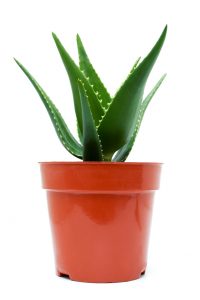The air in your home or office could be hazardous to your health! Most people spend a majority of their time indoors, so it’s important the air you breathe is healthy. Stagnant indoor atmospheres are ideal for buildup of air pollutants with many factors contributing to poor air quality. Luckily, there are ways to help combat these pollutants.
Air Quality Culprits & Solutions
Your heating and air conditioning units do more than raise or lower the temperature of your home or office. They can also negatively impact air quality. Routine HVAC maintenance performed by a Cox Heating & Air Conditioning service specialist can help keep your systems clean and working properly to help reduce air pollution.
By-products of cleaning supplies, paints and other chemical-based products can be major culprits in air pollution. Invisible, floating particles like dust and pet dander further add to polluted air. One easy and affordable way to cut down on these contaminants is by utilizing houseplants.
The Power of Plants
While plants won’t rid your home or office of all contaminants, it’s been documented that they improve air quality. Potted plants can reduce invisible, floating particles in the air. Some are even known to remove chemical vapors and lower the amount of formaldehyde, xylene, benzene and a slew of other potentially dangerous substances you may unknowingly breathe in. Many air purifying plants are easy to care for, even if you don’t have a green thumb, and these seven houseplants top the list for providing cleaner, fresher and healthier.
- Spider Plants are some of the easiest to grow and are ideal for beginners or neglectful owners. They’re known to remove formaldehyde and xylene and may even battle carbon monoxide. They’re resilient, safe for pets and thrive in bright, indirect sunlight.
- Ficus/Weeping Figs are hardy plants that grow between 2-10 feet tall. They remove benzene, formaldehyde and trichloroethylene and enjoy bright, indirect sunlight. Their soil should be allowed to dry between watering and kept away from pets due to toxicity.
- Boston Ferns are relatively easy to grow but prefer cooler locations with high humidity and indirect light. They’re safe for pets and considered highly efficient filtering plants. They not only help rid environments of formaldehyde and xylene but also potentially expel mold from indoor air.
- Bamboo Palms are low maintenance plants that hate over-watering and grow best in bright, indirect sunlight. They’re excellent at filtering formaldehyde, but also do well removing benzene and trichloroethylene and are pet-friendly.
- Aloe Vera plants not only help purify the air but also promote serious health claims for wound healing, burn relief and anti-inflammatory properties. They’re hardy succulents that do well in full or indirect sunshine or even artificial light and require little water. Aloe plants remove formaldehyde and benzene but are toxic to pets.
- English Ivy helps eliminate stale, dry air and can also aid in the removal of airborne mold or fecal matter particles. Ivy requires direct sunlight for at least four hours per day and moist soil. Although it’s a top pick for those suffering from asthma or allergies, it’s not good for pets.
- Dracaena are common foliage plants that are simple to grow in bright, filtered light. They remove formaldehyde, benzene, xylene and trichloroethylene efficiently, but are another plant hazardous to pets.
You should research potential air purifying plants for watering and sunlight needs, possible pet hazards and overall ease of maintenance. Many plants are almost impossible to kill and provide you with cleaner, fresher, healthier air indoors.





Leave a Reply